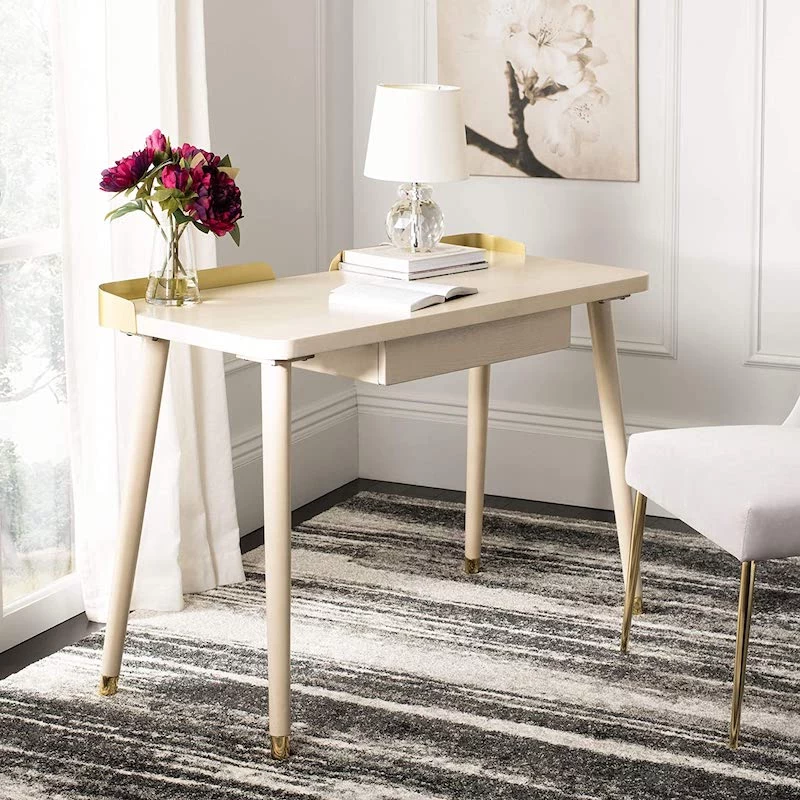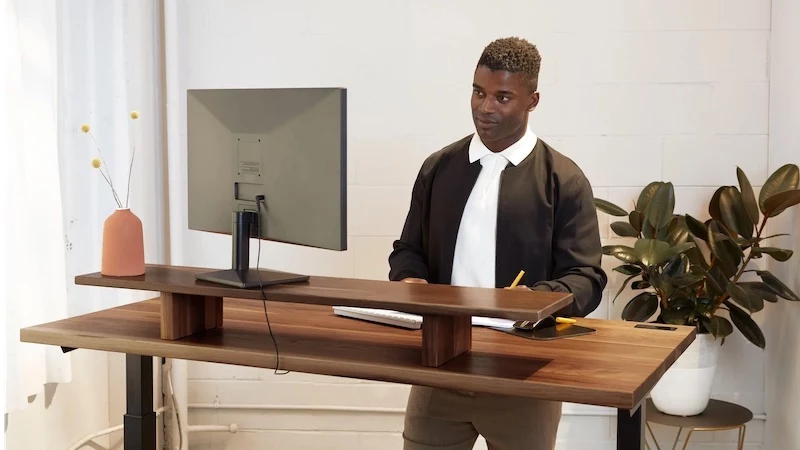Your Desk Is Sabotaging Your Focus. Here’s How to Fix It.
I’ve been helping people design better workspaces for a long time, and I’ve seen it all—from huge corporate offices to tiny desk setups stuffed into a spare closet. And you know what the number one request is? People want the secret to “productivity.” They’re looking for that one magic gadget or perfect layout that will suddenly unlock their focus.
In this article
But here’s the honest truth: my work isn’t about quick fixes. It’s about building an environment that supports you for the long haul, both for your focus and your health. A truly effective desk isn’t just a collection of cool accessories; it’s a professional tool that needs to be calibrated just for you.
Early on, the focus was purely on the physical stuff—getting monitors aligned and chairs adjusted based on standard ergonomic rules. It definitely helped with things like back pain, but it didn’t always solve the bigger problems of distraction and burnout. I quickly learned that your desk is a whole system. It impacts your body, your eyes, and even your mood. So, achieving real performance isn’t about buying more stuff. It’s about making smart choices that remove physical friction and let you do the hard work of thinking.

Let’s go beyond the basic checklists and dig into the principles that make a workspace actually work. I’ll walk you through the same techniques I use with my clients, explain the simple science behind it, and point out the common mistakes I see people make over and over again.
The Foundation: Your Body’s Connection to Work
Before we get into anything else, we have to talk about your body. Your desk, chair, and monitor are how you physically connect with your work. If this connection is off, nothing else matters. You can have the best to-do list in the world, but if your wrist is screaming in pain, you’re not getting anything done. This isn’t about comfort as a luxury; it’s about removing the physical distractions that quietly drain your brainpower.
The goal is to achieve a “neutral posture.” This just means your joints are naturally aligned, which reduces stress on your whole system. Imagine that relaxed, almost weightless feeling of floating in a pool—that’s what we’re aiming for at our desk. When you sit for hours with your neck bent forward or your wrists at a weird angle, your muscles are constantly working. This burns energy and sends a steady stream of discomfort signals to your brain, stealing focus from what you’re actually trying to do.

Your 5-Minute Desk Audit: Let’s Get This Right
Okay, stop reading for a second. Let’s do a quick audit of your current setup right now. How does it stack up? Just follow these steps.
1. Start with Your Chair (It’s Your Anchor)
Your chair is the foundation of everything. First, sit down and plant your feet flat on the floor. If they’re dangling, you need a footrest. And no, you don’t need to buy one right away—a stack of old textbooks or a sturdy shoebox works perfectly fine and is totally free. Now, adjust your chair height so your thighs are more or less parallel to the floor.
Make sure you’re sitting all the way back, so your lower back is pressed firmly against the chair’s lumbar support. One of the biggest mistakes I see is people spending a fortune on a great ergonomic chair and then perching on the front edge of it, getting zero of the benefits.

Heads up! If your chair has terrible back support, you have a couple of cheap options. A rolled-up towel wedged into your lower back can make a world of difference. If you want something a bit more permanent, you can find dedicated lumbar pillows online for about $25 to $40.
2. Align Yourself with the Desk
Now, pull your chair up to your desk. Your elbows should be at a comfortable, open angle—think somewhere between 90 and 110 degrees—with your forearms parallel to the floor. When you type, your wrists should be straight, not bent up or down. If your desk is too high, you’ll need to raise your chair and use that footrest. If the desk is too low, you might need to put some simple risers under the desk legs. This part is non-negotiable; a bad desk height is a major cause of shoulder and neck pain.
3. Position Your Monitor Correctly
This is where most people get it wrong. The rule is simple: the very top of your screen should be at or just a tiny bit below your eye level. This way, you’re looking at the center of the screen by glancing down slightly with your eyes, not by dropping your whole head. The monitor should also be about an arm’s length away. If you find yourself leaning in to read, either increase the text size in your computer’s settings or… maybe it’s time for an eye exam.

Got two monitors? Easy. Position your main monitor directly in front of you and your secondary monitor off to one side. You want to avoid straddling them in the middle, which forces you to constantly turn your neck.
The Big One: The Laptop Problem
Okay, let’s talk about the elephant in the room: the laptop. So many of us work directly off a laptop sitting flat on a desk, and to be frank, it’s an ergonomic disaster. The screen and keyboard are attached, which means if your hands are in the right position, your screen is way too low. If your screen is at eye level, your arms are held up in an awkward, tiring position. This is the primary cause of what everyone now calls “tech neck.”
Luckily, the fix is straightforward. You just need to separate the screen from the keyboard. Here’s the ideal setup:
-
A Laptop Stand: This raises your laptop so the screen is at eye level, just like a regular monitor. You can find good, sturdy ones for between $25 and $60 on Amazon or at any office supply store.
-
An External Keyboard: With your laptop on a stand, you’ll need a separate keyboard to keep your arms and wrists in that happy, neutral position. A basic one costs as little as $25, while nicer mechanical keyboards can range from $80 to $200.
-
An External Mouse: This completes the setup, allowing for a much more natural wrist and arm posture. A decent wireless mouse will set you back about $20 to $50.

Honestly, investing in this simple three-part system is probably the single biggest improvement you can make to your workspace, especially if a laptop is your main computer.
Where to Invest and Where to Save
You don’t need to spend a thousand dollars to get a comfortable setup. It’s all about making smart choices.
For example, when it comes to raising your monitor, you have options at every budget:
-
Good: A sturdy stack of books. Cost: Free!
-
Better: A basic monitor riser or stand. These give you a cleaner look and sometimes add a little storage. Cost: Around $30.
-
Best: A fully adjustable monitor arm. This clamps to your desk, freeing up space and giving you perfect control over height and distance. Cost: $80 and up.
The one place where it might be worth spending more is on a good ergonomic chair, especially if you sit for more than a couple of hours a day. Look for one with lots of adjustability—seat height, seat depth, armrest height, and good lumbar support. You can find decent options starting around the $300-$500 mark, while the top-tier professional models can run over $1,500. You don’t need the most expensive one, but the investment in an adjustable chair often pays for itself in comfort.

Wrapping It All Up
So there you have it. It’s not about magic, it’s about mechanics. By focusing on the core principles—getting your chair right, aligning with your desk, and positioning your monitor for your eyes—you remove the low-grade physical stress that chips away at your ability to concentrate. These small, intentional changes can have a massive impact, not just on how you feel at the end of the day, but on the quality of the work you produce.
Inspirational Gallery


A 2014 study published in the Journal of Experimental Psychology: Applied found that enriching a workspace with plants could increase productivity by 15%.
This isn’t just about aesthetics; it’s about biophilia—our innate tendency to connect with nature. Introducing a plant to your desk taps into this, reducing stress and boosting concentration. For a low-maintenance option that thrives in office light, consider a Snake Plant (Sansevieria) or a ZZ Plant. They require minimal watering and are known for their air-purifying qualities.

Does the color of your desk lamp’s light really matter for focus?
Absolutely. The color temperature of light, measured in Kelvin (K), directly influences your energy. For peak productivity during the day, opt for a cool, neutral light between 4000K and 5000K, which mimics natural daylight and promotes alertness. Warmer light (below 3000K) is better for winding down. Many modern desk lamps, like the BenQ ScreenBar, allow you to adjust the temperature to match your task and the time of day, reducing eye strain and supporting your natural circadian rhythm.

Noise-Canceling Immersion: Headphones like the Sony WH-1000XM5 create a bubble of pure focus, eliminating distracting chatter or construction noise. They are ideal for deep work sessions where you cannot be interrupted.
Situational Awareness: Open-ear headphones, like those from Shokz, use bone-conduction technology to let you listen to audio while remaining fully aware of your surroundings—perfect for when you need to hear the doorbell or a family member.
The right choice depends entirely on your role and environment. Do you need to block out the world or simply layer a soundtrack over it?
- Start each morning with a feeling of control, not chaos.
- Reduce the mental friction of deciding where to begin.
- Maintain the calm, productive environment you worked hard to create.
The secret? A simple, five-minute ‘desk reset’ at the end of each workday. Wipe surfaces, put away stray papers, untangle cords, and close unnecessary tabs. This small ritual signals the end of work and ensures you return to a space that’s ready for focus.










